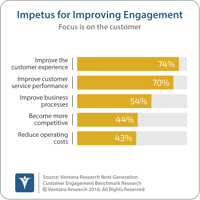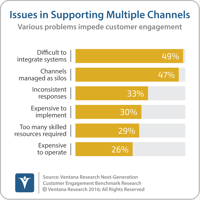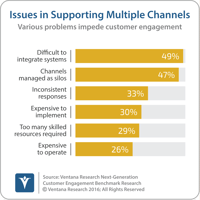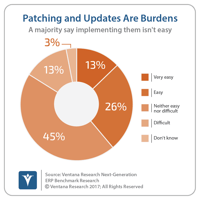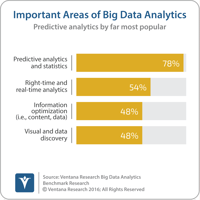Our benchmark research into next-generation customer engagement finds that three-quarters (77%) of organizations participating in the research said it is very important to improve the way they engage with customers. The two main drivers behind this are improving the customer experience (cited by 74%) and improving performance of the customer service organization (70%). This is important because most companies said their customers have good experiences, but only one-third said that experience is...
Read More
Topics:
Mobile,
Customer Analytics,
Customer Engagement,
Customer Experience,
Customer Feedback Management,
Cloud Computing,
Collaboration,
Customer Service,
Internet of Things,
Contact Center,
Digital Technology,
Omnichannel,
Customer Journey Maps,
Billing and Recurring Revenue
If we look at the focus of technology vendors for analytics and business intelligence or business applications providers deploying these capabilities in the last five years, we see that they have elevated the importance on the value of visualization and dashboards. These promotions might be understandable, but will they make business and the people using them more intelligent?
Read More
Topics:
Big Data,
Data Science,
Mobile,
Machine Learning,
Analytics,
Business Intelligence,
Cloud Computing,
Collaboration,
Information Optimization,
Digital Technology,
Machine Learning and Cognitive Computing
More than a year ago I wrote from personal experience about the challenges our firm encountered with Salesforce’s cloud computing systems and customer service and if we can trust them for business in the cloud. That perspective covered a range of issues that the behemoth cloud computing applications and platform company is facing regarding its service and technology. While Salesforce has shifted its customers like us and others to a different cloud computing environment, as it did in moving us...
Read More
Topics:
Big Data,
Sales,
Office of Finance,
Analytics,
Cloud Computing,
Collaboration,
Product Information Management,
Sales Performance Management,
Digital Commerce,
Sales and Operations Planning,
Machine Learning and Cognitive Computing,
Sales Enablement and Execution,
Machine Learning Digital Technology,
Sales Planning and Analytics
Our benchmark research into next-generation customer engagement shows that companies use, on average, seven channels of communication to engage customers. It also finds that supporting multiple channels leads to several challenges for organizations, chiefly difficulty of integrating systems (49%), channels managed as silos (47%) and inconsistent responses across channels (33%). Today’s customers have little sympathy for such problems – they quickly lose patience, and customer satisfaction...
Read More
Topics:
Customer Analytics,
Customer Engagement,
Customer Experience,
Office of Finance,
Customer Service,
Contact Center
I recently attended SuiteWorld, NetSuite’s annual user conference. In the opening keynotes and throughout the event speakers emphasized benefits for NetSuite users resulting from the merger of NetSuite and Oracle, completed last fall. I wrote about this at the time. NetSuite users are likely to benefit from Oracle’s sales and core technology infrastructure. Before the merger, NetSuite’s R&D spending was constrained by being a public company. The amounts needed to rebuild and extend its software...
Read More
Topics:
Human Capital Management,
Office of Finance,
Recurring Revenue,
Cloud Computing,
HRMS,
Enterprise Resource Planning,
ERP and Continuous Accounting
This year various types of organizations are embracing machine learning like it is going out of style – or maybe it would be better to say coming into style. And now with a little investigation on LinkedIn finds over half million professionals with machine learning in their job title. Machine learning is the application of specific data science algorithms that become more accurate as the system records more outcomes and processes more data. This improvement is referred to as “learning,” hence...
Read More
Topics:
Big Data,
Data Science,
Analytics,
Business Intelligence,
Cloud Computing,
Machine Learning and Cognitive Computing,
Machine Learning Digital Technology
I recently discussed how NICE continues to invest in its core products while creating a full customer experience platform, combining its core offerings with products newly acquired from inContact and Nexidia. During two recent briefings, I learned that these investments continue at quite a pace; the company announced a new product to address the ever-increasing number of channels of engagement, and another so that smaller centers with less sophisticated requirements can take advantage of a...
Read More
Topics:
Customer Analytics,
Customer Engagement,
Customer Experience,
Office of Finance,
Customer Service,
Contact Center
